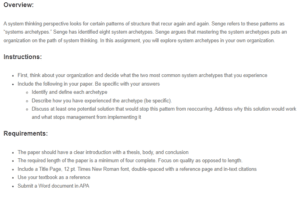System Archetypes in Organizations
According to Senge (2006), systems archetypes describe common behavioral patterns in organizations. These patterns offer an insight into underlying organizational structures that affect behavior over time. Managers can use systems archetypes to predict future unintended consequences. As diagnostic tools, systems archetypes offer managers an insight into future problems and their potential solutions.
Archetypes Experiences
One of the archetypes I have personally experienced at my organization is the ‘limits to success.’ This archetype offers an insight into limits to success- no matter the efforts an organization may put into a goal, growth will ultimately flatten (Braun, 2002). Once growth flattens, no growth will occur, no matter the pressure from the growth engine. The system archetype I experienced at my organization was when sales hit the limit and stopped growing at a retail store. The best way to deal with this archetype is to eliminate the limits instead of reinforcing the growth engine (Braun, 2002). Proactivity will help address the problem, but most managers only focus on their job description, making it hard to diagnose this archetype.
Another system archetype that affects systems is the tendency to shift burdens. ‘Shifting burdens’ occurs when there is a conflict between a short-term solution and a fundamental long-term solution (Senge, 2006). Managers face the pressure of implementing short-term solutions that bring instant gratification or well-thought-out solutions that may cost more and be hard to implement but bring long-term success. A personal experience related to this systems archetype is when managers had to introduce discounts to attract customers to solve the low sales crisis in our organization. This is a short-term solution that fails to address underlying issues that could be pushing away customers. The solution to this archetype is to focus on the fundamental solution (Braun, 2002). If it helps, a manager may implement a short-term solution to buy time as they work on a long-term solution. However, some managers may be unwilling to implement a long-term solution since it is not easy and requires effort.
Conclusion
In summary, systems archetypes act as diagnostic tools for organizational problems. Limits to growth and shifting the blame are some of the common examples of systems archetypes. These are discreet system features that affect the behavioral patterns in a system. Managers must exercise extreme attention to system details to discover and solve these system archetypes.
References
Braun, W. (2002). The System Archetypes. https://www.albany.edu/faculty/gpr/PAD724/724WebArticles/sys_archetypes.pdf
Senge, P. M. (2006). The Fifth Discipline: The art and practice of the learning organization. Doubleday.
ORDER A PLAGIARISM-FREE PAPER HERE
We’ll write everything from scratch
Question

System Archetypes in Organizations
Overview:
A system thinking perspective looks for certain patterns of structure that recur again and again. Senge refers to these patterns as “systems archetypes.” Senge has identified eight system archetypes. Senge argues that mastering the system archetypes puts an organization on the path of system thinking. In this assignment, you will explore system archetypes in your own organization.
Instructions:
- First, think about your organization and decide what the two most common system archetypes that you experience
- Include the following in your paper. Be specific with your answers
- Identify and define each archetype
- Describe how you have experienced the archetype (be specific).
- Discuss at least one potential solution that would stop this pattern from reoccurring. Address why this solution would work and what stops management from implementing it
Requirements:
- The paper should have a clear introduction with a thesis, body, and conclusion
- The required length of the paper is a minimum of four complete. Focus on quality as opposed to length.
- Include a Title Page, 12 pt. Times New Roman font, double-spaced with a reference page and in-text citations
- Use your textbook as a reference
- Submit a Word document in APA


